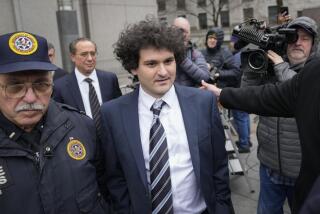Auditor Pays $400 Million for Not Signaling S&L; Crisis
- Share via
WASHINGTON — Ernst & Young, the nation’s second-largest accounting firm, on Monday paid the federal government a record $400 million to settle claims that the firm’s auditors failed to warn of disastrous financial problems that caused some of the nation’s biggest thrift failures.
The staggering settlement, with $300 million coming from insurance and $100 million from the firm’s partners, represents the largest financial victory by the government against the professional auditors and accountants who contributed to the thrift crisis, regulators said.
Ernst & Young was the auditor at institutions involved in some of the most publicized and costly savings and loan association collapses, including Lincoln Savings & Loan of Irvine, Silverado Banking Savings & Loan of Denver, Vernon Savings & Loan of Dallas, and Western Savings & Loan of Phoenix. If Ernst & Young hadn’t settled, the government would have filed legal actions for at least $1 billion, involving alleged misdeeds at 12 institutions, Harris Weinstein, general counsel for the Office of Thrift Supervision, told a news conference.
“We consider this a very important step forward to completing the cleanup of the thrift industry,” Weinstein said. “This establishes a standard for now and the future to govern the audit of depository institutions.”
The government has collected larger civil settlements: $600 million from junk bond king Michael Milken, who pleaded guilty to securities law violations, and $500 million from his former firm, the defunct Drexel, Burnham Lambert.
But Monday’s Ernst & Young payment to the government focused on a special issue: The appropriate behavior of professionals such as lawyers and accountants whose clients became enmeshed in the financial scandals that have brought down hundreds of thrifts and banks. Federal financial regulators claimed that many lawyers and accountants ignored laws and rules as well as ethical standards in their work at the failed thrifts and banks.
Ernst & Young audited more than 300 banks and thrifts during the 1980s, and 40 failed institutions were the subject of close scrutiny by government investigators. The charges against Ernst & Young included failure to make adequate allowances for loan losses, improper accounting for mergers, improper counting of income from phony sales, and failure to disclose dubious deals between the S&Ls; and some major customers. At Lincoln, for example, Ernst & Young “failed to challenge Lincoln’s fictitious sales of real estate, which were used to inflate Lincoln’s profits,” according to the OTS.
In an aggressive campaign against accountants and lawyers, the federal regulatory agencies have been following a theme suggested by U.S. District Judge Stanley Sporkin, who said in an opinion in a 1990 case involving Lincoln Savings: “Where . . . were the outside accountants and attorneys . . . ? What is difficult to understand is that, with all the professional talent involved (both accounting and legal), why at least one professional would not have blown the whistle . . . “
The previous record settlement for professional firms was a $41-million agreement earlier this year by the OTS with the New York law firm of Kaye, Scholer, Fierman Hays & Handler.
Ernst & Young said Monday it decided to settle the claims rather than face years of legal battles. “Although this is a costly settlement, it is the only realistic solution to an endless stream of lawsuits that would have been even more expensive to defend,” said Ray J. Groves, the firm’s chairman.
“Contesting each lawsuit would have meant many years of almost continuous litigation--and an unacceptable drain of the firm’s time and financial resources,” he said. “Moreover, even favorable court decisions are often little more than moral victories that require substantial outlays of time and money.”
The $300 million from insurance proceeds will be covered by syndicates associated with Lloyd’s of London, according to regulators. Groves said the other $100 million will come from the firm’s operations, $25 million a year for the next four years. This will not have a “significant” effect on the yearly earnings of the firm’s partners, according to Groves.
The settlement was announced jointly by the OTS, which supervises thrifts; the Federal Deposit Insurance Corp., a bank regulatory agency; and the Resolution Trust Corp., the agency handling the disposal of more than 700 failed thrifts.
About $272 million will go to the FDIC, while more than $128 million will go to the RTC, regulators said.
The cost to the taxpayers from the failures of thrifts handled by Ernst & Young will run to billions of dollars. The government’s decision to settle was based on a calculation of the insurance coverage, the assets of the firm and its partners, and the potential cost of fighting the firm in court, according to Weinstein of the OTS.
In Monday’s settlement, the firm accepted a consent order, neither admitting nor denying the allegations of improper auditing practices. Former partners Jack Atchison and Edward F. Flaherty and current partner George Derr signed consent decrees prohibiting them from working for government insured banks and thrifts. Six current partners and one former partner signed decrees requiring them to take additional professional training.
More to Read
Inside the business of entertainment
The Wide Shot brings you news, analysis and insights on everything from streaming wars to production — and what it all means for the future.
You may occasionally receive promotional content from the Los Angeles Times.










